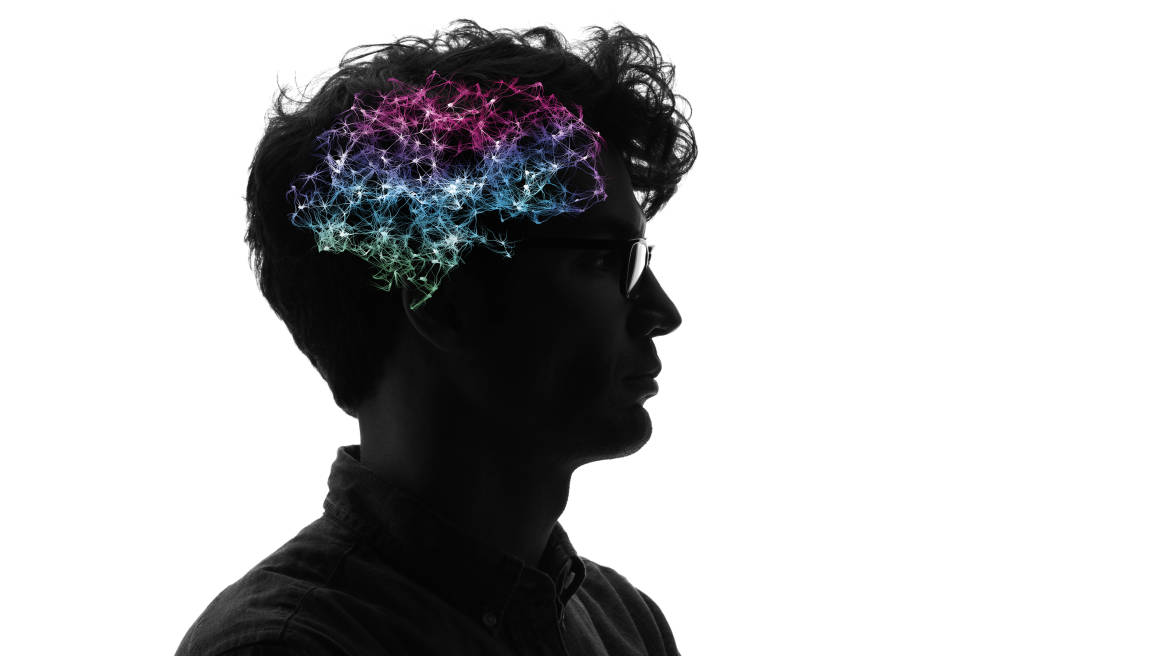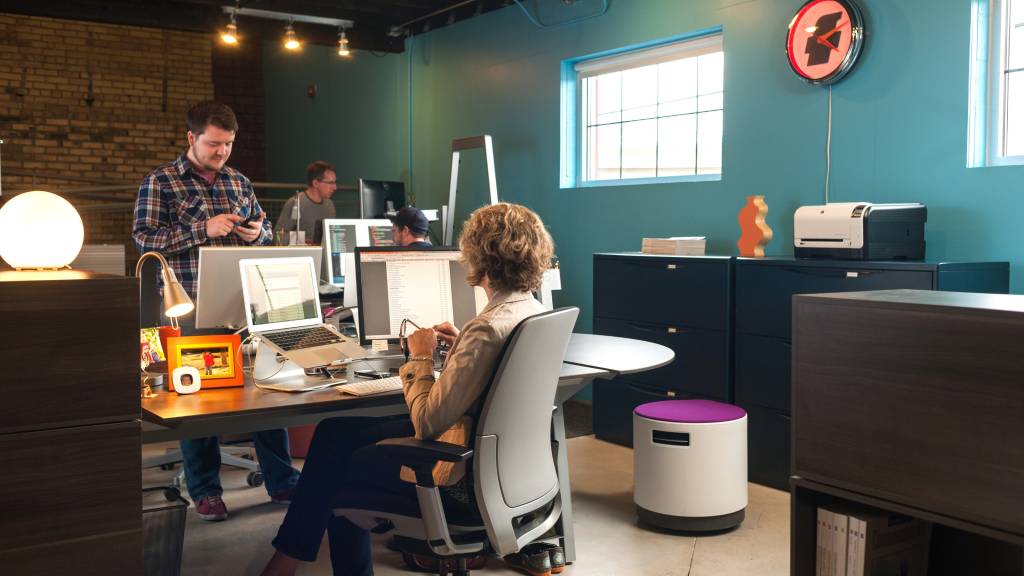Think Better
Neuroscience: The Competitive Advantage
No matter how interested you are in this article, you probably won’t finish reading it right now, especially if you’re at work.
Yet another urgent text will come in, you’ll get a string of new email alerts, you’ll overhear a colleague at the next workstation mention your name during a videoconference so you’ll turn your attention to what that’s all about, you’ll still be trying to catch up on your emails when your boss will stop by to ask about that proposal you’ve been trying to finish all week, which will prompt you to go online to browse for some more information and then, since you’re online anyway and didn’t take a lunch break and starting to feel really resentful about the impossible amount of the work you’re expected to do and how hard it is to focus, you’ll stop off at Facebook and notice that today is the birthday of your best friend from college, so you’ll read the 73 messages she’s received so far and then decide, what the heck, you’ll give her a call while you’re still catching up on email and then, before you know it, you’re almost late for your third meeting of the day and feeling more stressed than ever, so you’ll get a large black coffee with an extra shot of espresso and try to work on the proposal during the meeting.
Too Much Information
Scenarios of near-constant distraction at work have become the norm versus the exception for most people today. It’s well said that a wealth of information creates a poverty of attention, and most workers are now living that mental skirmish every day. At the same time that we’re drowning in information, we’re also expected to process it faster, getting to insights, recommendations, decisions or at least next steps rapidly. In minds as cluttered as a scrap yard, we scramble to find something that will “make do,” responding to the pressure for action.
It’s well said that a wealth of information creates a poverty of attention, and most workers are now living that mental skirmish every day.
Yet, we long to be more effective at our jobs. We keep telling ourselves: Just be more focused, just work harder. But, in reality, no matter how hard we try, our brains just don’t work that way. While our higher-level cognitive skills distinguish us from other mammals, being attuned to what’s going on around us is also embedded in our evolution, a key to survival. This means that today’s way of working has become a Catch 22: We’re taking our natural inclination to be distracted and training our brains to be even more so.
With attention meltdowns now epidemic in many organizations, nearly everyone is struggling to adapt, often without any real understanding of what attention is, how it works, or how to attain it and use it productively. Fortunately and just in time, the research of neuroscientists in more than 40,000 labs throughout the world is shedding new light on the processes of attention and, in so doing, providing decipherable clues into how it can be supported in the workplace.

Thanks to the vast amount of research being done, it’s now becoming clear that solving many of the challenges that people face at work is linked to getting smarter about that three-pound organ that we all carry around in our heads.
During the past year, Steelcase researchers and designers have been delving into the findings of neuroscientists and cognitive researchers, integrating discoveries from these experts with their own ongoing investigations into workers’ behaviors and the changing nature of work. The resulting convergence of findings has inspired new perspectives and new ideas for how environments, when thoughtfully designed, can be a hardworking and effective tool to help workers better manage their attention. And that has all kinds of competitive advantages: improved worker engagement and wellbeing, more creativity and innovation, and better business results overall.
“As demands on people’s attention grow, it is becoming more and more important to optimize our cognitive resources,” says Donna Flynn, vice president of the WorkSpace Futures team. “By studying the findings of neuroscientists, we’re realizing that knowing more about how our brains shape our physical, cognitive and emotional wellbeing is bringing more clarity to understanding human needs in the workplace. We’re learning what we can do with all this new science to help people think better at work.”
why we’re so distracted?
| 3 minutes | How frequently the average office worker is interrupted or distracted University of California, Irvine |
| 23 minutes | How long it takes to return to a task after being interrupted University of California, Irvine |
| 204 million | Emails sent per minute Mashable |
| 8 | Average number of windows open on worker’s computer at the same time “The Overflowing Brain: Information overload and the limits of working memory,” Torkel Klingberg |
| 30 | Average number of times per hour an office worker checks their email inbox National Center for Biotechnology Information |
| 221 times | How often the average smartphone user in the UK checks their phone every day Tecmark |
| 4.9 billion | Connected devices in use in 2015 Gartner |
| 200 percent | Increase in average time spent on mobile devices since 2012 GlobalWebIndex |
| 49 percent | Workers who can’t choose where to work depending on the task Steelcase wellbeing study, global average of 17 countries |
Attention: This is Your Brain
Dictionaries give simple definitions for attention; in general terms, it’s about holding something in your mind. But cognitive researchers have a much more nuanced understanding, classifying different types of attention based on which areas of the brain are involved. For example, as a professor in Sweden’s esteemed Cognitive Neuroscience Karolinska Institute, Torkel Klingberg, M.D., Ph.D., delineated two distinct types: controlled attention and stimulus-driven attention. The former is about intentionally directing our attention; the latter is about things that attract it.
It’s now known that there are multiple biological mechanisms involved in attention. The prefrontal cortex, often described as the executive center or the CEO of the brain, is the director of our attention. It’s the last major region to develop in our evolutionary history, and it’s what enables us to selectively focus on something. But neuroscientists tell us there’s more to attention than just this one part of our brains.
“To understand attention, we need to think of it holistically in terms of multiple brain functions, but also contextual issues such as the content our brains are processing, our physical state and the environment,” explains Beatriz Arantes, a WorkSpace Futures researcher and organizational psychologist.
Our psychological state of arousal—in other words, how alert we are—is a significant factor because as it fluctuates, our attention fluctuates. When we’re tired and lethargic, it’s difficult to control our attention. When we’re highly excited, our minds also jump from one thing to another. Sustaining our attention depends upon a moderate, “sweet spot” level of arousal.
Another key brain system affecting attention and arousal is the limbic system: dispersed parts of the brain that manage emotion. More primal than the prefrontal cortex, the limbic system prompts us to pay attention to stimuli that elicit fear or excitement. John Medina, a developmental molecular biologist at Washington State University with research interests in human brain development, writes, “We don’t pay attention to boring things.” In other words, human brains respond naturally to the unexpected, which makes us easily distractible. Evolutionarily speaking, being attuned to changes in our environment has been important to survival, and we still retain those natural tendencies to notice sounds, movements and stimuli around us.
Scientists have proven that when we think we’re multitasking, we’re really switching our attention rapidly between things.
Of course, not all distractions are external. We’re also distracted by internal thoughts and concerns. Neuroscientists at MIT Trey Hedden and John Gabrieli found that internally generated lapses in attention are activated by the medial prefrontal cortex, a specific part of the prefrontal cortex that’s triggered by thoughts of ourselves or other people. The medial prefrontal cortex is part of the brain’s default network, our naturally occurring state of mind when we’re not focused elsewhere.
Attention is also a function of motor orientation— how close we are to sensory stimuli affects how closely we pay attention to them. Students who sit close to the teacher have an easier time paying attention that those who sit far away, people having a conversation tend to lean in instinctively and fix their eyes on the person who is talking—even when that results in staring at a speakerphone throughout a conference call.

How Brains Work at Work
Most people still regard neuroscience research as a pathway to eventual cures for mental illnesses and disorders such as Alzheimer’s, unaware of the possibility of any immediate impact on their everyday lives, according to a report in the journal Science Communication. In reality, however, just as medical research into pathologies has produced a wealth of findings for improving our physical health, neuroscience research is producing findings that have relevance for improving our everyday cognitive functioning.
In particular, Steelcase researchers have targeted three key findings from neuroscience that have important implications for how we perform at work.
Brains get tired.
It’s common to see organizations operating on the assumption that focus is the pathway to productivity and the goal, therefore, is to keep people as focused as possible for at least eight hours a day—the more, the better.
Neuroscientists, however, tell us that focus is a limited resource. Like the rest of our bodies, our brains consume energy, drawing on glucose and oxygen as fuel. Controlled attention, in particular, is very hard work, drawing heavily on the prefrontal cortex. Activities such as analyzing, prioritizing, planning and other types of critical thinking are energy guzzlers. As energy supplies dwindle, brains get tired.
Because our brains consume so much energy, humans developed physiological mechanisms over time to ensure that we wouldn’t waste our finite supply. That’s why, as the prefrontal cortex becomes taxed with a difficult or irrelevant task, we’re more likely to become distracted. It’s a simple energy-saving mechanism, like turning down a thermostat. “Our brains work in cycles of peak activity and downtime, moving between rhythms of energy expenditure and regeneration,” says Arantes.
“Our brains and bodies are designed to move through these rhythms, to stay alert so we can respond to other important environmental cues.”
Problems arise if we try to stay focused when our brains are tired. Distractions abound, and we end up avoiding difficult tasks, learning little, remembering less and making mistakes. As stress mounts, the emotionally driven “fight or flight” syndrome kicks in, flooding the nervous system with cortisol and adrenaline. In the resulting state of over-arousal, instead of doing productive work, people who are stressed become consumed by irritation, guilt, pessimism and other unproductive states of mind.
“Never in history has the human brain been asked to track so many data points.”
Edward M. HallowellAuthor and Psychiatrist
Noted psychiatrist and author Edward M. Hallowell has identified a neurological phenomenon he terms “attention deficit trait.” He says it’s a direct result of what’s happening to people’s brains in today’s hyperkinetic environment. “Never in history has the human brain been asked to track so many data points,” he says, concluding that this overloading of the brain’s circuits is the primary reason that smart people are underperforming at work. We’re simply expecting more of our brains than they have the energy to handle.
“It’s as if the brain is on a budget. If it devotes 70 percent here, then it can only devote 30 percent there,” reports Sergei Gepshtein, a computational neuroscientist at the Salk Institute for Biological Studies who researches how the brain processes visual stimuli.

Multitasking attention is inefficient.
A persistent work trend in recent years has been people juggling simultaneous projects and responsibilities, each requiring frequent collaboration with a variety of people to keep everything moving forward. Our jobs depend on streams of information and interaction, and our efforts to manage everything at once have led to widespread efforts at multitasking—responding to emails during a meeting, reading a text in the middle of a conversation, browsing the Web while we’re talking on the phone, trying to accomplish multiple tasks at the same time.
Although we’d like to believe otherwise, scientists at places such as the Brain, Cognition and Action Laboratory at the University of Michigan have proven that when we think we’re multitasking, we’re really switching our attention rapidly between things. One exception: If multitasking involves completely separate channels of the brain—for example, walking (a manual task) and talking (a verbal task)—it can be done, says David Meyer, a faculty member at the university and one of the world’s research experts on multitasking. But in today’s workplaces many activities compete for our attention, demanding “airtime” on channels in our brain that can handle only one thing at a time. Meyer has likened people’s distraction behaviors of today to smoking cigarettes decades ago, before we knew what it was doing to our lungs. In a similar way, he says, many people today aren’t aware of how much they’re degrading their mental processes as they attempt to multitask throughout the day. On a small scale, this may mean errors in our emails that make our intended meaning unclear; on a larger scale, it can mean a serious accident due to texting while driving.
People today aren’t aware of how much they’re degrading their mental processes as they attempt to multitask throughout the day.
The direct contrast to multitasking is what psychologist Mihaly Csikszentmihalyi, Ph.D., has famously named “flow”—being completely immersed in a challenge over time. It’s considered by many to be our most productive state. Flow rarely happens by accident, and it can’t be sustained indefinitely. During flow, however, we’re absorbed and engaged in what we’re trying to accomplish. Unlike stress, which releases chemicals associated with over-arousal and fear, flow is a highly pleasurable and highly productive state of arousal. It’s what many employees—and their employers—crave more of in today’s workplaces.
Mindfulness trains the brain.
As much as we’re attracted to the idea of flow, actually achieving that state of mind is a bigger challenge than ever for most workers today. Linda Stone is a writer and consultant who coined “continuous partial attention” almost 20 years ago, and it has only become more prevalent since then. Continuous partial attention is an effort not to miss anything. “We want to effectively scan for opportunity and optimize for the best opportunities, activities, and contacts, in any given moment,” Stone writes. On high alert, we feel busy and important. When used as our dominant attention mode, however, continuous partial attention puts us in a constant state of crisis, making us feel overwhelmed and unfulfilled, as well as powerless to do anything about it. By trying to stay connected to everything, we fail at connecting to anything in a meaningful way.
Probably one of the most remarkable discoveries from neuroscientists’ research is neuroplasticity —i.e., evidence that people can physiologically change their brains at any time of life by creating, strengthening and consolidating neural networks. This means that, instead of constantly succumbing to distractions because we’re trying to hold too many things in our minds at once, we have real opportunities to “train the brain” into positive habits.

Mindfulness—keeping your mind turned into the moment of here and now—appears to be one of the best ways to accomplish this. One of the most dramatic proofs is research led by Richard Davidson, Ph.D., who has pioneered the science of meditation as director of the Waisman Laboratory for Brain Imaging and Behavior and the Center for Investigating Healthy Minds at the University of Wisconsin–Madison. Davidson and his team have used digital imaging to look at the brains of Buddhist monks who had practiced meditation intensely for years, each accumulating more than 30,000 hours of meditation. Their brain scans showed powerful gamma activity, indicating intensely focused thought. In fact, the monks’ gamma waves were 30 times as strong as those of a control group of college students. Instead of getting lured into distracting thoughts or environmental stimuli, these monks had trained themselves to focus at will.
Continuous partial attention puts us in a constant state of crisis, making us feel overwhelmed and unfulfilled.
Of course, spending thousands of hours every year in mindfulness meditation isn’t a likely scenario for office workers. But research published in the journal Psychiatry Research: Neuroimaging shows that even as little as 30 minutes of mindfulness a day for eight weeks can physiologically change the brain. While making and strengthening connections in our brains, mindfulness also reduces sensitivity to the brain’s threat-detection network.
“Essentially, engaging in mindfulness means that we are practicing our ability to recognize when our minds have wandered and gaining ability to redirect our attention. The process of nonjudgmental observation of thought trains your brain and allows you to calm your responses and maintain more emotional stability. The more we practice this, the better we get at it,” explains Arantes.
Course-Correcting For Optimized Brainpower
Especially when considered together, the key findings from neuroscience that Steelcase researchers have explored in depth all point to one unambiguous conclusion: It’s impossible for any worker to engage in eight hours or more of controlled attention and meet any reasonable expectations for either quality or quantity outputs. Brains get tired easily, and trying to multitask attention is counterproductive and stressful. Although mindfulness is a proven way to strengthen brain functioning, most workplaces lack adequate support for regenerative activities.
The way to increase productivity and creativity is not about always trying to do more focused work or put in more hours, conclude Steelcase researchers. Instead, it’s about getting smarter about the brain, learning its limitations as well as how to leverage it to full capacity to direct our attention, and inspire and challenge us in different ways throughout the workday.
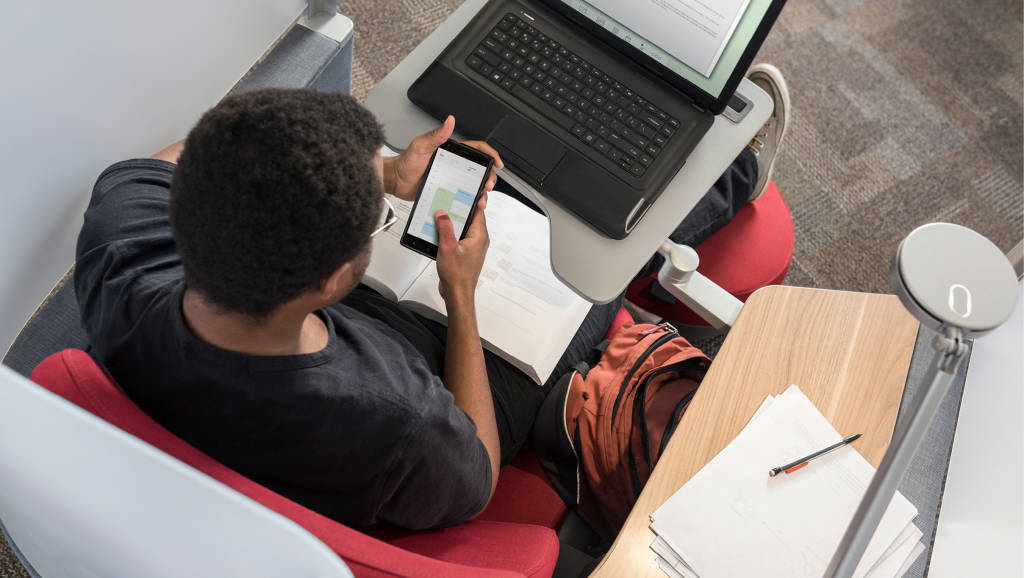
Respecting the Rhythms of our Brains
Part of the problem of our distraction, and the solution, lies in ourselves. By changing our existing habits, we can gain more control of our brains—and our lives. As we become more knowledgeable about how our brains work and more attuned to the ebb and flow of our attention, it becomes easier to recognize what our brains need when. Steelcase researchers and designers have identified three brain modes that each require distinct behaviors and settings:
Focus: When we need to deeply focus on something, it’s important to avoid unwelcome distractions. Whether the distractions are external or internal, every time we switch our attention we burn through finite neural resources and increase opportunities for the limbic system to hijack our focus.
Whether it’s turning off our phones for awhile or completely overhauling how we manage our day or just getting more sleep, a widening circle of expert authors is offering a steady stream of helpful tips in books, magazine articles, interviews and online media, suggesting various behaviors that we can adopt to focus our brains more productively.
Regenerate + Inspire: Although self-regulation is necessary for controlled attention it’s important to recognize that distractions can be opportunities to give our brain the timeout it needs and then let our minds go where they will. Although daydreaming has taken on generally negative connotations in the work world, as it turns out our brains are still working when they wander, even though we feel like we’re not.
“The neurons are forging new pathways versus focusing on what you already know. And that’s when insights really start developing,” says Flynn. “That old adage about focusing too hard so you can’t see the forest through the trees and the stereotype of ‘aha’ moments in the shower or driving to work—now we know that those really have a scientific component. Neuroscience helps us understand that often the best way to solve a problem is to walk away from it and let your brain do the work subconsciously.”
Activate: When we need to activate our arousal, moving our bodies is the key. Although we may have learned otherwise in school, static sitting sabotages our ability to concentrate. Numerous studies have proven that movement boosts attention by pumping oxygen and fresh blood through the brain and triggering the release of enhancing hormones. While the physical and emotional benefits of movement are well established, neuroscience has proven it also enhances cognition.
Harvard’s John Ratey comprehensively explores the connection between exercise and the brain in his book “Spark: The Revolutionary New Science of Exercise and the Brain.” He explains that when our bodies are moving, we stimulate production of the protein BDNF (brain-derived neurotrophic factor), which he describes as “Miracle-Gro for the brain,” fueling the birth of new neurons.
Another very recent validation of the benefits of movement: A study recently published in Computers in Human Behavior concluded that students who read something at a treadmill desk were 34.9 percent more likely to answer a question about it correctly than their sitting counterparts. They also reported paying more attention to their work, and their electroencephalography readings showed more signs of attentiveness and better memory.
Design Strategies
Focus
Deep focus requires avoiding unwelcome external and internal distractions. This library zone is designed as a retreat from the noise distractions and frequent interruptions that are common in open-plan offices. Phone use is prohibited and conversations are restricted. Designed with a range of acoustical, visual and psychological boundaries, these settings support a wide range of user preferences for focused work.

Layers of boundary—from fully enclosed spaces to micro lounge settings—enable users to control external stimuli—sound, sightlines, lighting and temperature to their individual preferences.
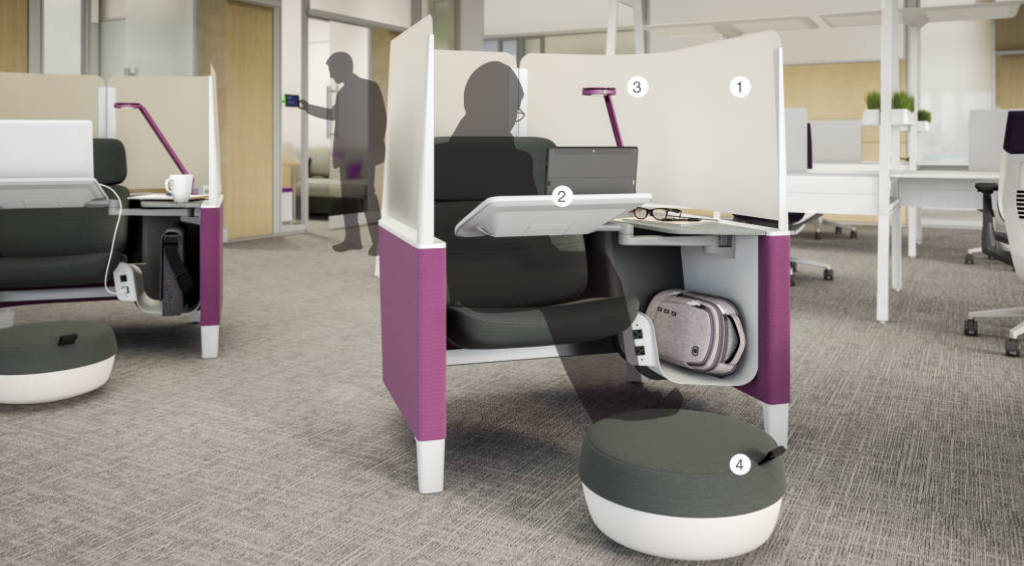
Brody WorkLounge, a cocoon-like setting, cuts down on visual distractions and provides an empowering sense of control and psychological safety.
- Screen eliminates visual distraction
- Adjustable table orients user to work
- Light illuminates personal content
- Ottoman enables ergonomic wellbeing
REGENERATION AND INSPIRATION
Easy access to colleagues, nourishment and places to rest the mind helps cognitively-overwhelmed workers gain a new perspective.
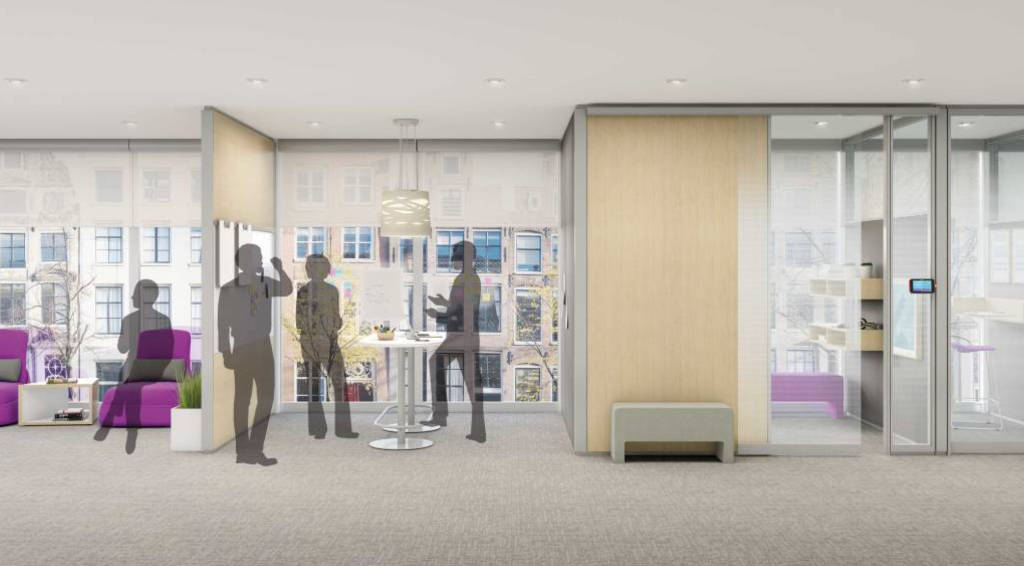
These settings incorporate opportunities for movement—whether a stand-up
brainstorm session or a walk during a conference call, this activity refreshes the
mind as well as the body.

- A fireplace surrounded by natural wood encourages calm contemplation and is also a hub for quiet conversation.
- A coffee bar provokes serendipitous encounters and conversations, while a media wall invigorates the mind with interesting company information and news from around the world.

An informal lounge setting encourages relaxed postures and dynamic exchanges that provoke new ways of thinking.

Activation: Physical activity has proven to stimulate the brain. Provide easily accessible settings that encourage workers to move throughout the workday to activate their minds and also take care of their bodies.
These settings incorporate opportunities for movement – whether a stand-up brainstorm session or the possibility to adjust the workstation to work in a standing posture for a while.
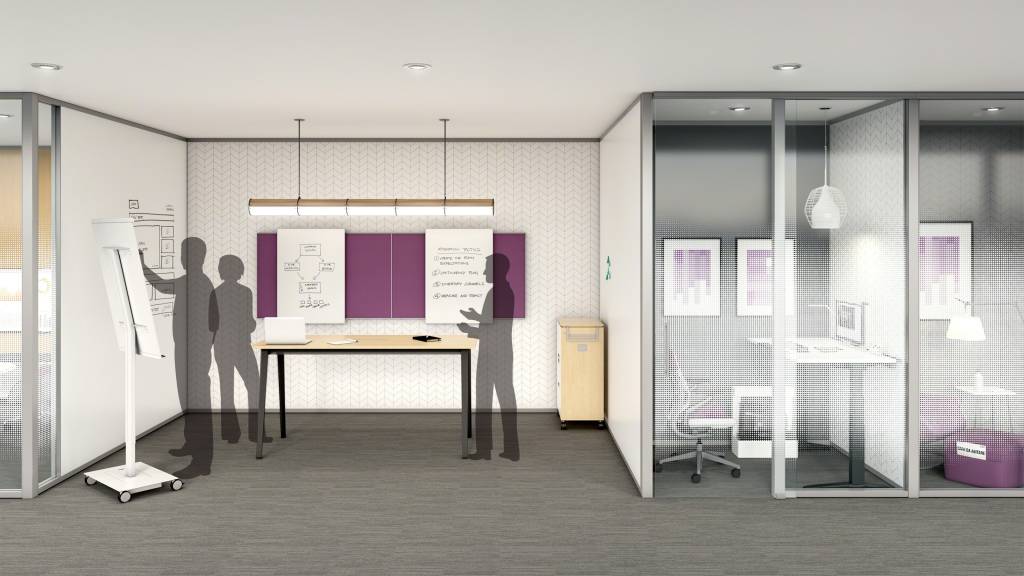
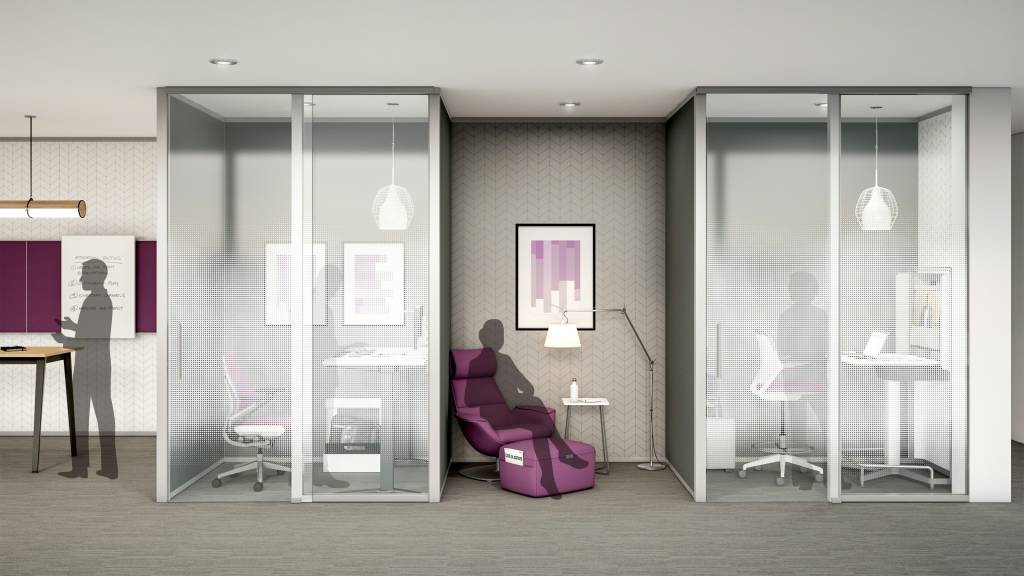
Whiteboards capture information and ideas, reducing cognitive load to encourage creative thinking.
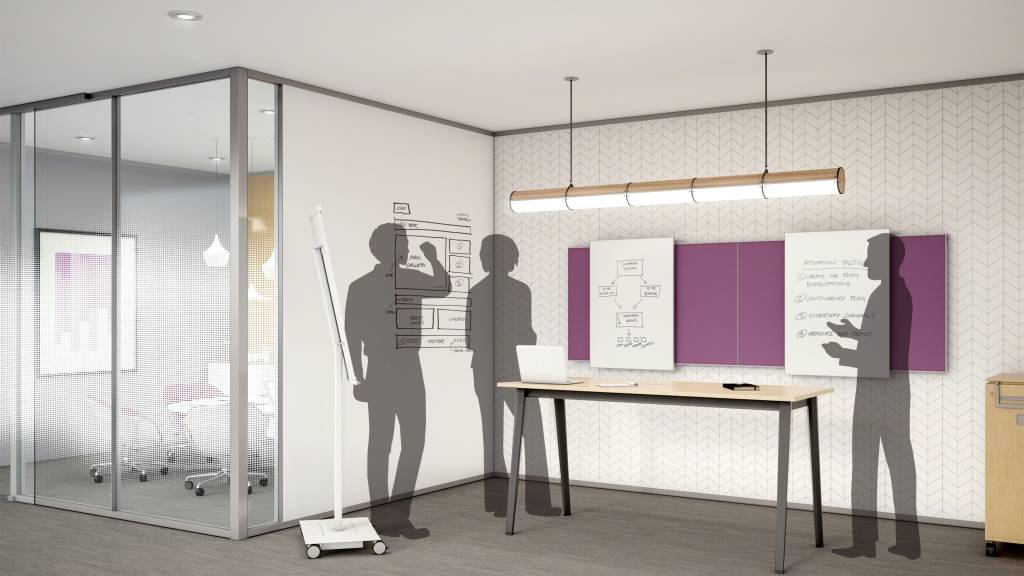
Introducing New Research on Engagement
+ the Global Workplace
1/3 of workers in 17 of the world’s most important economies is disengaged, according to new research from Steelcase. Working with global research firm Ipos, the Steelcase Global Report is the first to explore the relationship between engagement and the workplace.

